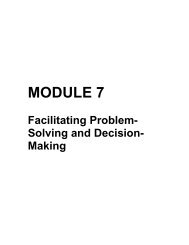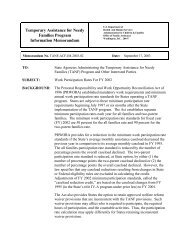Delivering Training and Technical Assistance - Administration for ...
Delivering Training and Technical Assistance - Administration for ...
Delivering Training and Technical Assistance - Administration for ...
You also want an ePaper? Increase the reach of your titles
YUMPU automatically turns print PDFs into web optimized ePapers that Google loves.
• On a sticky note or index card, ask participants to write, “A belief I have about _____ [subjectmatter of training] is…”. Have them pair up with someone across the room <strong>and</strong> share their belief.Each person then partners with a new person, but shares the belief he/she just heard from his/her lastpartner instead of his/her own. Participants continue like this <strong>for</strong> a few minutes, allowing the beliefsto be widely shared. Bring participants back together <strong>and</strong> solicit examples from the large group.2. Create a safe space. Learning something new can be a vulnerable experience, <strong>and</strong> a trainer can supportlearning with low-risk activities, reassurance, <strong>and</strong> a plan <strong>for</strong> building incremental successes. Conceptsshould be presented in a strategic sequence, from simple to complex, group-supported to solo.Strategies <strong>for</strong> incorporating into training session:• Thoughtfully plan sessions to start simple <strong>and</strong> work towards complex concepts.• Establish ground rules.• Avoid embarrassing individuals <strong>and</strong> affirm offerings from individuals that speak up.• Set feasible learning objectives.• Allow small groups to interact with one another.• Provide an outline to guide participants toward the intended outcomes <strong>and</strong> takeaways, facilitatingdiscussions <strong>and</strong> peer-sharing based on that outline.3. Respect learners/participants as individuals. Establish sound relationships with participants, includingrespect <strong>and</strong> open communication. Provide <strong>for</strong> their needs with adequate breaks, use their time effectively,<strong>and</strong> provide <strong>for</strong> opportunities <strong>for</strong> input on the schedule or process.Strategies <strong>for</strong> incorporating into training session:• After presenting the agenda, check in with your audience.• Provide breaks.• Offer choices <strong>and</strong> allow <strong>for</strong> self-direction.• Be flexible <strong>and</strong> adaptive to participant needs.• Conduct frequent check-ins, asking <strong>for</strong> feedback.• Review the three learning styles in the appendices <strong>and</strong> teach to all three in the training session.4. Include structured activities. There are three aspects of learning—ideas (cognitive), feelings (affective),<strong>and</strong> actions (psychomotor). <strong>Training</strong>s are most effective when they move beyond cognitive into affective<strong>and</strong> psychomotor. <strong>Training</strong>s that provide opportunities to practice the new skill learned will increase thelikelihood of behavior change. Likewise, people are more likely to believe something they have learnedif they arrive at the idea themselves, <strong>and</strong> activities foster the exploration needed <strong>for</strong> participants to createtheir own ideas.Strategies <strong>for</strong> incorporating into training session:• Once every ten minutes, give participants two minutes to discuss the concepts presented with apartner.• Ask guiding questions <strong>and</strong> facilitate a discussion.11
















